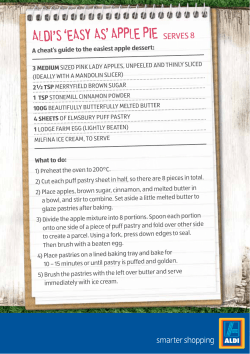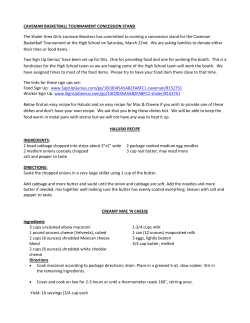
43 SESSION AT-A-GLANCE WHO? HOW LONG?
43 SESSION AT-A-GLANCE WHO? HOW LONG? Introduction Facilitator 10 minutes The Game Facilitator, audience 25 minutes Debrief and Discussion Facilitator, audience 10 minutes Source, History and Resources for More Information Why Use This Game • To teach that systems only work as well as they are designed. Information about this game comes from Qualis Health, • To teach the importance of error-proofing design. the QIO for Washington State, and its Performance • To show the importance of clearly documenting Improvement Support Center. your process. Materials Target Audience For this game, you will need: • Senior staff, team members, and anyone else who will Ingredients for a peanut butter and jelly sandwich (bread, peanut butter, jelly, knife) be involved in creating a new process or altering an existing process. Type of Game • A pad of paper and pens for each team • Flip chart and markers to record the key points of the discussion A demonstration with everyone participating. Preparation Key Concepts To prepare for this session: • • • • Familiarize yourself with the session’s structure Each system is perfectly designed to achieve the and content: results it gets. - Read through the game instructions and key teaching points in their entirety. Clear instructions to one person may not be clear instructions to another. - Practice the game itself. Steps early in a process may have an unforeseen impact - Practice presenting the key teaching points. • later in that process or system. Prepare the room: - Arrange chairs around a table or tables, set up to make it easy for the participants to work in small groups. - Set up a small desk or table in the front of the room and place the sandwich ingredients on the table. - Set up the flip chart so you can capture key points of the discussion after the game. NYSDOH AI NQC Game Guide August 2006 Peanut Butter and Jelly Game Peanut Butter and Jelly Game 44 Playing the Peanut Butter and Jelly Game Background to the Game Facilitator’s note Welcome and Introductions “A system is defined as a collection of interdependent ele- To begin the game, welcome participants and thank them ments that interact to achieve a common purpose.” It is the for their participation. If necessary, ask individuals to intro- interaction of systems that makes them tricky to manage duce themselves to the group. – something that affects one part of a system may have an unforeseen impact later on another part of the system. In Learning Objectives thinking about making improvement, we have to under- Tell participants that by the end of the session they will: stand that each system is perfectly set up to achieve the • Understand that systems and processes only work as well results it gets. If we want to change the results, we need as they are designed. to change the system. For example, the number of women • Understand what is involved in error-proofing a design. getting gynecology consults will not improve unless you do • Appreciate the importance of clear documentation of something to change the link between the processes in your process steps. program and those in the gynecology service. Agenda The purpose of this game is to teach the link between design Provide a brief description of the session’s primary and results, and to stress that decisions that make sense components: when taken in isolation (like how to put peanut butter and 1. Background to the Peanut Butter and Jelly Game. jelly on bread) can have an unexpected impact on the result. 2. The game itself. As you play your role, stick strictly to the instructions as 3. Debrief and discussion on what the game shows, and given, and “play up” the result. Participants will quickly how its lessons can be applied to HIV care. grasp the relationship between clear documentation of the 4. Feedback and close. process and the resulting sandwich, but may need help from you to make the link to thinking about health care systems. Key points to explain to your audience: • Explain the definition of “process” and “system.” A process is a series of steps that turns an input into an output. A system is a group of processes with a common aim. A patient visit is a process. Treating HIV is a system. • Mention that improving one process in a system may have an unforeseen impact on another process in a system. Most people will understand this easily; if you have time, discuss some examples of this that you or participants have encountered. • Explain that this game will help illustrate some of the issues involved in improving processes and systems. NYSDOH AI NQC Game Guide August 2006 45 The Game Itself • • - Have they made improvements that have had unfore- 3 or 4 groups. seen consequences? How have they handled these? Tell each group to prepare, write down and submit the What might they do differently? (This can be a place process for making a peanut butter and jelly sandwich. to bring up the concept of PDSA: testing changes on Reconvene as a large group. You, as facilitator, demon- a small scale can reveal these problems early.) strate each set of instructions for making the sandwich. Follow these instructions exactly as written – for Feedback and Close example, if the instructions don’t tell you to take the peanut butter out of the jar, don’t take it out of the jar. • • • Ask your audience for feedback on whether this session Ask the group: do we adopt, adapt or abandon this met its objectives. Take notes of their response on a flip process? Discuss why. chart, and keep it for your use in the future. If time permits, try one round of adaptation • of the instructions. Schedule an informal follow-up session with any audience member who wants clarification or more information on the game or the concepts you discussed. Debrief and Discussion • Thank your audience and congratulate them on their hard work and success. • Review results. • Ask the group to describe what happened: • Provide sandwiches to those who want them. - Aim for comments that the instructions assumed people would know to do certain things, even if they were not stated. - Ask if this situation ever occurs in their organization, and discuss. • Ask for feedback on your role as a sandwich-maker: - Did you follow directions? - Did your result reflect what the instructions contained? (Aim to get participants to see that the results perfectly matched the instructions.) - What therefore needed to be changed, to achieve the expected result? (The underlying way of doing work – the core instructions for making the sandwich.) • Discuss the application of what they have learned to their own HIV program: - What is the link between the current design of their HIV care system and the results it achieves? - What about existing process instructions? Are they clear and well understood? NYSDOH AI NQC Game Guide August 2006 Peanut Butter and Jelly Game • Divide the participants into small groups. Aim for
© Copyright 2025





















